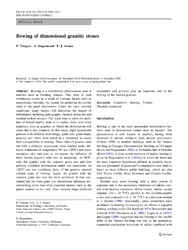Bowing of dimensional granitic stones
Vázquez, P.
Siegesmund, S.
Alonso, F.
63, 7/8: 1603 - 1612
DOI: https://doi.org/10.1007/s12665-010-0882-y
Persistent URL: http://resolver.sub.uni-goettingen.de/purl?gldocs-11858/6795
Persistent URL: http://resolver.sub.uni-goettingen.de/purl?gldocs-11858/6795
Vázquez, P.; Siegesmund, S.; Alonso, F., 2010: Bowing of dimensional granitic stones. In: Environmental Earth Sciences, Band 63, 7/8: 1603 - 1612, DOI: 10.1007/s12665-010-0882-y.
 |
Dokument öffnen: |
Bowing is a well-known phenomenon seen in marbles used as building veneers. This form of rock weathering occurs as a result of external factors such as temperature, humidity, the system for anchoring the marble slabs or the panel dimensions. Under the same external conditions, many factors will determine the degree of deformation including petrography, thermal properties and residual locked stresses. The usual way to solve the problem of bowed marble slabs is to replace them with other materials, such as granites, in which the deformation still exists but is less common. In this study, eight ornamental granites with different mineralogy, grain size, grain shape, porosity and fabric were tested in a laboratory to assess their susceptibility to bowing. Three slabs of granite, each cut with a different orientation, were studied under different conditions of temperature (90 and 120°C) and water saturation (dry and wet) to investigate the influence of these factors together with that of anisotropy. At 90°C, only the granite with the coarsest grain size and low porosity exhibited deformation under wet conditions. At 120°C and wet conditions, three of the granites showed evident signs of bowing. Again, the granite with the coarsest grain size was the most deformed. It was concluded that the wide grain size distribution influences microcracking more than other expected factors, such as the quartz content of the rock. Also, mineral shape-preferred orientation and porosity play an important role in the bowing of the studied granites.
Statistik:
ZugriffsstatistikSammlung:
- Geologie [933]

